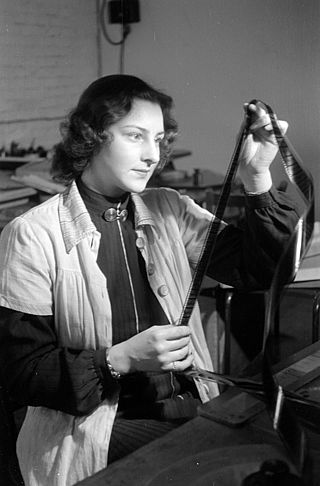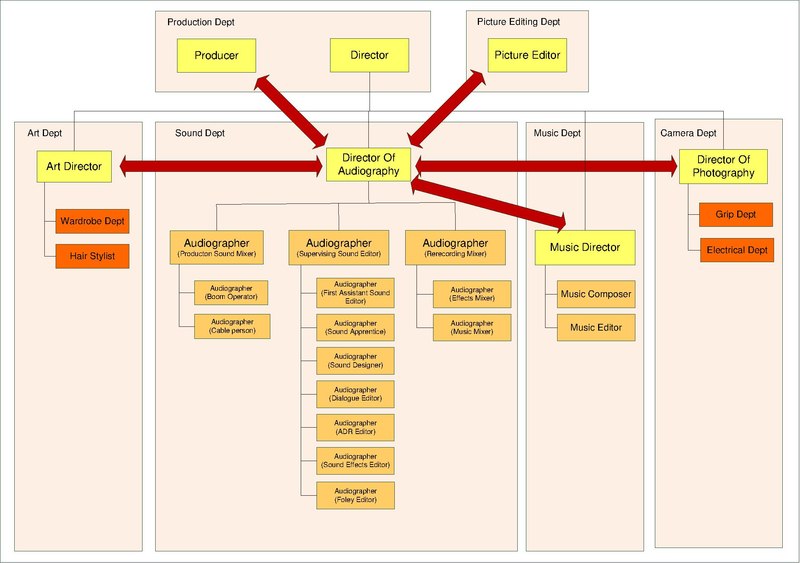
Film editing is both a creative and a technical part of the post-production process of filmmaking. The term is derived from the traditional process of working with film which increasingly involves the use of digital technology. When putting together some sort of video composition, typically, you would need a collection of shots and footages that vary from one another. The act of adjusting the shots you have already taken, and turning them into something new is known as film editing.
A film crew is a group of people, hired by a production company, for the purpose of producing a film or motion picture. The crew is distinguished from the cast, as the cast are understood to be the actors who appear in front of the camera or provide voices for characters in the film. The crew is also separate from the producers, as the producers are the ones who own a portion of either the film studio or the film's intellectual property rights. A film crew is divided into different departments, each of which specializes in a specific aspect of the production. Film crew positions have evolved over the years, spurred by technological change, but many traditional jobs date from the early 20th century and are common across jurisdictions and filmmaking cultures.

A production sound mixer, location sound recordist, location sound engineer, or simply sound mixer is the member of a film crew or television crew responsible for recording all sound recording on set during the filmmaking or television production using professional audio equipment, for later inclusion in the finished product, or for reference to be used by the sound designer, sound effects editors, or Foley artists. This requires choice and deployment of microphones, choice of recording media, and mixing of audio signals in real time.
A film producer is a person who oversees film production. Either employed by a production company or working independently, producers plan and coordinate various aspects of film production, such as selecting the script, coordinating writing, directing, editing, and arranging financing.
"Below-the-line" is a term derived from the top sheet of a film budget for motion pictures, television programs, industrial films, independent films, student films and documentaries as well as commercials. The "line" in "below-the-line" refers to the separation of production costs between script and story writers, producers, directors, actors, and casting and the rest of the crew, or production team.
Sound design is the art and practice of creating soundtracks for a variety of needs. It involves specifying, acquiring or creating auditory elements using audio production techniques and tools. It is employed in a variety of disciplines including filmmaking, television production, video game development, theatre, sound recording and reproduction, live performance, sound art, post-production, radio, new media and musical instrument development. Sound design commonly involves performing and editing of previously composed or recorded audio, such as sound effects and dialogue for the purposes of the medium, but it can also involve creating sounds from scratch through synthesizers. A sound designer is one who practices sound design.
In film and television, the production designer is the individual responsible for the overall aesthetic of the story. The production design gives the viewers a sense of the time period, the plot location, and character actions and feelings. Working directly with the director, cinematographer, and producer, production designers have a key creative role in the creation of motion pictures and television. The term production designer was coined by William Cameron Menzies while he was working on the film Gone with the Wind. Production designers are commonly confused with art directors as the roles have similar responsibilities. Production designers decide the visual concept and deal with the many and varied logistics of filmmaking including, schedules, budgets, and staffing. Art directors manage the process of making the visuals, which is done by concept artists, graphic designers, set designers, costume designers, lighting designers, etc. The production designer and the art director lead a team of individuals to assist with the visual component of the film. Depending on the size of the production the rest of the team can include runners, graphic designers, drafts people, props makers, and set builders. Productions Designers create a framework for the visual aesthetic of a project and work in partnership and collaboration with the Set Decorator & Set Decorating department to execute the desired look.
Art director is the title for a variety of similar job functions in theater, advertising, marketing, publishing, fashion, film and television, the Internet, and video games.
Filmmaking or film production is the process by which a motion picture is produced. Filmmaking involves a number of complex and discrete stages, beginning with an initial story, idea, or commission. Production then continues through screenwriting, casting, pre-production, shooting, sound recording, post-production, and screening the finished product before an audience, which may result in a film release and exhibition. The process is nonlinear, as the director typically shoots the script out of sequence, repeats shots as needed, and puts them together through editing later. Filmmaking occurs in a variety of economic, social, and political contexts around the world, and uses a variety of technologies and cinematic techniques to make theatrical films, episodic films for television and streaming platforms, music videos, and promotional and educational films.
Television crew positions are derived from those of film crew, but with several differences.

Motion Picture Sound Editors (MPSE) is an American professional society of motion picture sound editors founded in 1953. The society's goals are to educate others about and increase the recognition of the sound editors, show the artistic merit of the soundtracks, and improve the professional relationship of its members. The society is not to be confused with an industry union, such as the I.A.T.S.E. The current president is Mark Lanza. The names of active members of the MPSE will generally appear in film credits with the post-nominal letters "MPSE".
The set decorator is the head of the set decoration department in the film and television industry, responsible for selecting, designing, fabricating, and sourcing the "set dressing" elements of each set in a Feature Film, Television, or New Media episode or commercial, in support of the story and characters of the script. The set decorator is responsible for each décor element inside the sets, from practical lighting, technology, art, furniture, drapery, floor coverings, books, collectables, to exterior furnishings such as satellite dishes, Old West water troughs, streetlamps, traffic lights, garden furniture and sculptures.
Camera coverage, or coverage, is the amount and kind of footage shot used to capture a scene in filmmaking and video production. The film editor uses coverage in post-production to assemble the final cut.
Previsualization is the visualizing of scenes or sequences in a movie before filming. It is a concept used in other creative arts, including animation, performing arts, video game design, and still photography. Previsualization typically describes techniques like storyboarding, which uses hand-drawn or digitally-assisted sketches to plan or conceptualize movie scenes.
Articles related to the field of motion pictures include:

David Lewis Yewdall was an American supervising sound editor. He worked with Roger Corman on Battle Beyond the Stars and as the co-supervising sound editor on Talvisota. He published a book about the profession in 2007, Practical Art of Motion Picture Sound, which was called a "must-read for all students of film." In 1996, he became a member of the board of NightPro Technologies Inc (NTI), a sound production company from Provo, Utah. He taught editing and sound at the University of North Carolina School of the Arts until June 2016.
The VFX creative director is a position common in films, television programs, and computer games using a large amount of visual effects (VFX).
Lisa Fruchtman is an American film and television editor, and documentary director with about 25 film credits. Fruchtman won the Academy Award for Best Film Editing for The Right Stuff (1983). With her brother, Rob Fruchtman, she produced, directed, and edited the 2012 documentary Sweet Dreams.
George Watters II is an American retired sound editor with more than 80 feature film credits. He has won the Academy Award for Best Sound Editing twice, for The Hunt for Red October (1990) and for Pearl Harbor (2001).
Cecelia Hall is an Oscar winning sound designer and sound editor. She was the first woman to be nominated for an Academy Award for Best Sound Effects Editing for Top Gun and went on to win the Oscar for The Hunt for Red October, a film for which she also received a nomination for the BAFTA Award for Best Sound at the 44th British Academy Film Awards.




